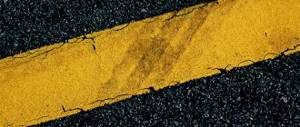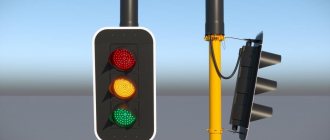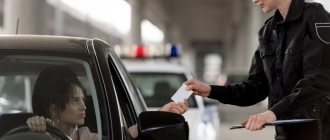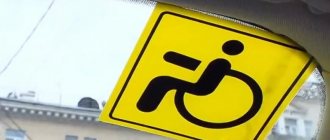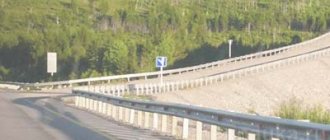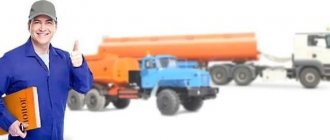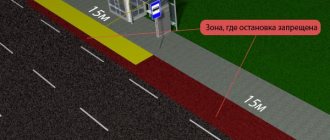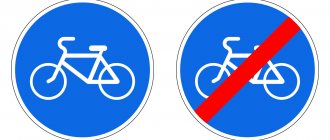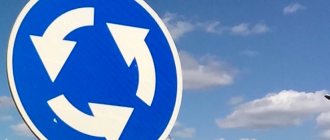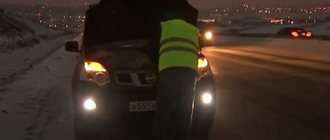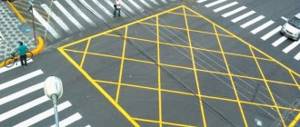Requirements of the sign Intersection of equivalent roads
Before an intersection with roads of different significance, a road sign must be installed for the intersection of roads of equal significance 1.6.
As a rule, road sign 1.6 is installed on roads with the same surface, for example, asphalt, dirt and others. Traffic on one of these roads cannot be defined as the main one, and traffic regulation according to the rules for crossing equivalent roads comes to the rescue.
When approaching an intersection, the driver must make sure that there are no obstacles to traffic on the right side. Therefore, it is often said that the passage of equivalent roads occurs along the obstacle on the right.
Also, a driver entering an intersection and turning left at the same time as an oncoming car, which in turn is turning right, the first driver also experiences interference on the right.
Thus, the driver should always give way at the intersection to the car that appears on the right.
Regulated intersection
The rules have a clear wording of regulated and unregulated forks. Thus, a controlled intersection is an intersection of roads at which the order of traffic is established by means of a traffic light or a traffic controller. In turn, an unregulated intersection is a fork in the road where there is no traffic controller and traffic light, or there is a traffic light with a yellow flashing signal. At such a road intersection, the order of passage is determined by signs, markings and traffic rules.
Now let's take a closer look at the situations that the passage of controlled intersections promises.
Regulated equivalent intersection
Rules for driving through intersections.
Driving through controlled intersections The concept of “regulated” indirectly indicates that the traffic order rules at this intersection are determined in two ways:
- through a traffic light;
- through the regulator.
It cannot be regulated by signs, because otherwise the roads will no longer be considered equal and priorities will be set. There are a number of important rules regarding movement at these intersections:
- If the regulating device, the traffic light, is working properly, all drivers must follow the basic rules. This applies to all intersections.
- If there is a traffic controller at the intersection, drivers are required to follow his commands. The fact is that sometimes it is necessary to adjust the movement manually even when the traffic light is working. In these cases, the traffic controller will be in charge of the road.
- If you are driving at a red traffic light with an additional green arrow, you need to give way to all cars that are on the same path as yours.
It is sometimes useful to re-read the traffic rules; sometimes it helps a lot in difficult situations. Driving through an uncontrolled intersection of equal roads is one such case. In any case, always be careful and extremely polite.
As the traffic rules state, today there are several ways to regulate intersections, these are:
- Traffic light;
- Traffic signs;
- A traffic police and traffic police officer, that is, a traffic controller;
In addition to regulating intersections with the intervention of third parties or special equipment (signs or traffic lights), there are additional rules that, in the absence of all components, can resolve the dispute.
Today it is:
- Uneven road surfaces
. The surface of the road determines the role of traffic at the intersection along it. That is, if the intersection is the intersection of a gravel and asphalt surface. The road with an asphalt surface is considered the main one. - Right hand rule
. If the traffic of the intersection is not regulated in any way and the road surface is equal, then we are guided by the “obstacle on the right.” That is, all those vehicles that are on the right have a primary role, which means that the driver on the left gives way.
According to the traffic rules, an intersection where the traffic order is not regulated by traffic lights, traffic police officers, that is, a traffic controller, signs, as well as an intersection where the roads have the same surface, is an unregulated intersection of equivalent roads.
From here we get that an equivalent road is a section of the road that is not regulated, either by signs or devices, where there is no traffic controller. At the same time, the road coverage is equal. A crossroads of equivalent roads is an intersection of streets where the directions are equal in meaning.
Then, as the traffic rules say, the driver must follow the right-hand rule. That is, let everyone who is on the right side of the intersection pass. In turn, the driver who moves along the intersection on the right side has the main road and should not allow vehicles on his left to pass.
Rules for driving at controlled intersections
The traffic order on the roads provides for variations in intersections that a motorist may encounter. This automatically requires the formation of separate groups of instructions indicating how and where such areas can be passed without creating dangerous conditions for other people.
It should be remembered that the regulations in force at intersections with direct regulation will differ from those that coordinate traffic on unregulated sections of the road. Conventionally, the requirements for passing intersections, which are classified as regulated parts of the road, can be divided into two separate categories.
The first group includes the following:
- if the traffic light operates in standard mode (red - yellow - green), then the designated priority encountered on the road loses its force;
- You can begin the maneuver only when the appropriate instructions are given, while maintaining the lane;
- it is required to give way to motorists who are already completing their maneuver at the intersection, as well as to pedestrians, including when giving permission from a traffic light;
- if there are additional signs indicating the direction for movement, you can move in the desired direction only if such a sign is turned on;
- when the additional section and the prohibiting signal are operating, you can only move in the direction of the lit arrow, but subject to the condition of yielding the crossing to the car that is moving on the other side;
- If the instructions of the traffic controller contradict the instructions of the traffic light, you should act as directed by the authorized person; his orders are mandatory and have the highest priority.
You should also remember that any maneuvers must be understandable to other drivers.
For example, if you need to slow down at an intersection, then first press the brake lightly to give a stop signal, and if you need to drive through a section quickly, then you need to maintain the speed that will help the car behind you to cross a specific part of the road. Regardless of the type of intersection and the intensity of the traffic flow at it, you should lower the speed limit in order to avoid collisions with cars coming from other sides of the road.
You should also remember such precautions as reducing speed if the driver approaches a red traffic light. In this case, you need to stop only if the car does not have time to be near the stop line before the green light. This will allow you not to create a traffic jam at the exit from the intersection, but to move smoothly, but without violating traffic rules.
In addition, it is important to remember the queue in which the driver is when leaving a controlled intersection. If the car is the first, then you need to get underway as quickly as possible so as not to delay other road users. If the driver is second, third, and so on in line, then for safety reasons you should start at the same time as the one in front.
The second group of rules is special, that is, specifically established situations that are possible at an intersection are considered. This would include moving straight, right or left.
Go straight
This option is a common type of traffic at an intersection, which leads to traffic violations and even accidents. The bottom line is that even if there is regulation at the intersection, regardless of what type is provided, road markings, dividing strips or other signs are missing or poorly visible, which makes it difficult to move in the right direction.
For multi-lane intersections, of which the absolute majority are, special markings are provided, which indicate with arrows which direction and from which lane you can drive. This allows you to avoid collisions and displacement of cars from adjacent lanes.
Often, driving straight becomes impossible precisely because the driver occupies the wrong lane, which does not allow movement in the desired direction.
There are two ways out of this situation that will allow you to avoid breaking the rules:
- Change route. If you had to turn right or left, you can use another path to get to the place.
- Return to the intersection. In this situation, it is enough to drive to the nearest U-turn and return to the starting position, but with placement in the correct lane.
An attempt to change lanes at the stop line, displacing neighboring cars, can lead to driving into the oncoming lane and causing a traffic accident.
Separately, it should be said about moving straight, when two road intersections are determined at once. The problem arises when the first one is passed, and the red light comes on before the second one. Stop or continue moving? The traffic rules determine that stopping is mandatory only if there is a stop line before such a second intersection; if not, then you can continue driving even if there is a prohibiting traffic light sign.
Even if in the absence of a stop line you can move further along the intersection, there are practical cases in which it is better to reduce your speed. We are talking about “blind spots” when the road has insufficient visibility on the right side. The driver must assume that there may be a vehicle coming from the other direction, which may not necessarily slow down, which will ultimately lead to a collision. Accordingly, you need not only to remember the traffic rules, but also to analyze the situation, taking measures to avoid accidents.
Movement to the right
Making turns and U-turns on the section of roadway in question is always a dangerous maneuver, since drivers must control not only their own actions, but also those of motorists who are in adjacent lanes or who are stopping in front of the car.
A right turn made at an intersection is carried out only from a specifically designated lane, namely the far right. The required part of the road is determined by markings and road signs.
A common problem associated with driving to the right at an intersection is control over the actions of the car on the left. According to the rules, one must drive straight, as indicated by the markings and signs; however, situations often arise when motorists cut off cars on the right, preventing them from making a safe turn maneuver.
Such actions are recognized as a direct violation of traffic rules, however, they can only be prevented through attentiveness, which will allow you to timely see the intentions of the “neighbor” in the lane. Firstly, such a turn is unacceptable from the middle lane, secondly, it can contribute to a collision, since one driver cuts off the other, and thirdly, it may cause harm to pedestrians who are also not expecting such a maneuver.
Traffic regulations in this situation do not help motorists in any way. You can fine the violator, but this will not prevent an accident, so those driving at the intersection to the right from the outer lane just need to carefully monitor the actions of neighboring cars and, if something happens, apply the brakes in time.
As for the behavior on the road of those directly driving to the right, the main thing here is to decide who needs to be allowed to pass:
- cyclists, regardless of which direction they are coming from, since the traffic rules do not apply to them;
- pedestrians.
According to the rules of lane markings, other cars from neighboring directions of movement do not intersect in any way with the car that intends to go to the right, accordingly, there is no need to let anyone pass.
What could be an insoluble situation at a crossroads?
Rules for traveling through railway crossings
A traffic situation may arise at an intersection from which it is impossible to find a way out within the framework of current traffic rules.
It consists in the fact that cars approach an equivalent intersection simultaneously from all directions. Moreover, at each of the four entrances there is at least one car whose driver wants to drive straight, turn left or turn around.
The essence of this insoluble situation is that each driver must give way to the other car (which is on his right). White is inferior to orange, orange is inferior to blue, blue is inferior to green, green is inferior to white. Therefore, they are all forced to stand and cannot pass.
A way out of this situation can be found as follows. All vehicles approaching from one direction must turn right. In this case, the remaining cars will gradually be able to move apart.
However, if such a situation arises in practice, I do not recommend that you show off your knowledge and be the first to turn right. Let other drivers do it better.
This is due, firstly, to the fact that when approaching the intersection, you have already taken the correct position on the roadway, corresponding to the intended exit direction. Therefore, turning to the right from such a position can lead to a violation of the rules or an accident.
Secondly, the driver has no information about where the right road will lead him and whether he will be able to turn around there. Therefore, it is better to wait until the situation resolves itself, remaining in your place in front of the intersection.
Well, in the next article we will talk about intersections with tram tracks.
Good luck on the roads!
The intersection of equivalent roads can often involve situations the exit from which will not comply with traffic rules.
Such a case can occur when cars arrive at the same time and at the same time on each of the 4 sides there is at least one that is going to go straight or make a U-turn. The intractability of the situation lies in the fact that each driver is obliged to give way to another car located on his right side, because of this, everyone else remains at the intersection and is not able to pass.
But the following way out can be found - all transport that comes from one direction can turn right, and other cars will move away over time. But still, if this situation arises, then if you are not in a hurry, then the best advice would be not to make the first turn to the right, but to wait, so as not to risk it again.
This is so because you yourself, having approached the intersection, have already taken a certain position from which you are going to exit, and if you start turning right, this can often be like a violation of the rules. It also often happens that when you turn right, you end up in an unknown place where you can’t even turn around normally, so the best option would be to take your time, no matter what the load, and then drive through it calmly.
Help for a novice driver
When driving straight, novice drivers sometimes create an emergency situation by starting to brake sharply when they see that someone on the right is starting to drive through an additional traffic light that allows them. This is a gross mistake, because, being at an intersection and heading straight to the main traffic light, you have the right of way.
When turning right after leaving the intersection, as already mentioned, you should be careful in choosing a lane, as there is a possibility of ending up in oncoming traffic. That’s why they came up with the expression “from the far right to the far right.” It is very easy to remember and follow.
When turning left, never lose sight of the oncoming direction, especially when the traffic lights have already changed to prohibitory. Because cases of “arriving” vehicles appearing are not uncommon.
Uneven roads
Which driver making a turn will break the rules?
An intersection where one road is the main one, and there is confirmation of this in the form of road signs, and the other is secondary, is called an intersection of unequal roads.
The main road is identified by the "Main Road" or "Give Way" signs.
Thus, we find that there are also intersections of unequal roads. Here, traffic is already carried out according to the principle of the main and secondary roads in accordance with the signs.
All vehicles on the main road, regardless of their direction, have priority after entering the intersection.
However, if the “Main Road” sign has a direction, then the relationship between drivers moving along the main and secondary roads is preserved.
If the movement of the vehicle and the sign diverge, the vehicle that was considered the main one when entering the intersection initially allows those moving along the direction of the sign to pass, and then continue moving.
Let's talk about how to properly drive through intersections of equivalent roads.
First of all, you need to understand that an intersection of equivalent roads is necessarily an unregulated intersection. There are no traffic controllers or traffic lights here. Or there are traffic lights, but they do not work or are switched to yellow flashing mode:
A yellow flashing signal informs drivers that the intersection has become unregulated. There are no priority signs; both paved roads are an intersection of equivalent roads.
If there are no traffic lights at all and no priority signs, this is also an intersection of equivalent roads.
At such intersections, drivers must set their own driving order, guided by the general principle of “interference on the right.”
In other words, the Rules simply placed all responsibility for the safety of passage through the intersection on the driver who has “impediment on the right.”
“Give way (do not interfere)” is a requirement that means that a road user must not start, resume or continue moving, or carry out any maneuver if this may force other road users who have priority over him to change direction. movement or speed.
Not only should you not “continue moving,” but you also should not “resume” it! That is, stop and stand until the threat of a collision (due to your fault) disappears.
Let's look at possible situations.
In this situation, no one has interference on the right. Both can continue moving. And if both need to go straight or to the right, they will pass the intersection without stopping (trajectories of movement do not intersect).
They can even turn left or turn around at the same time. If, of course, it is possible to pass safely on starboard sides. In this case, the motion trajectories also do not intersect.
There is only one situation when the trajectories exactly intersect! This is if one moves straight or to the right, and the oncoming person turns left or turns around. Initially, the oncoming player had no interference on the right. The obstacle on the right arose while driving through the intersection. And here, at the crossroads, he must give way to us.
Of course, three or four vehicles can converge at an intersection, and there are such problems in the Tickets. But this doesn’t fundamentally change anything. The following is fundamental:
The intersection of equal roads is the most democratic of all intersections.
Here everyone has an equal right to travel.
And with an equal right to travel, the general principle of “interference on the right” always comes into play.
Here's how you'll be asked about it in the exam:
You intend to turn left. Your actions?
- Go through the intersection first.
- Pass the intersection at the same time as the oncoming car until the motorcycle passes.
- Be the last one to cross the intersection.
Correct answer: 3. You will be the last one to cross the intersection.
You have arrived at an uncontrolled intersection of equal roads and must give way to a motorcyclist approaching from the right, and he, in turn, gives way to a car approaching him from the right.
U-turn
In general, according to traffic rules, the rules for turning at a signalized intersection are similar to turning left, but there are minor differences. So, when changing the direction of movement to the opposite, you do not cross the path of pedestrians in your vehicle.
The traffic rules do not clearly state which lane the turn should be completed in. Therefore, if you have a choice, then choose the one that is most convenient for you. However, it is clearly stated that turning around at a signalized intersection is carried out only from the leftmost lane and no other.
Before making a turn, it is imperative to give way to vehicles that are moving from the opposite direction straight or to the right.
Rules for driving through an uncontrolled equivalent intersection
Driving through such an intersection must be done with caution, given that you can always meet a driver who has forgotten the rules or is confident that he is moving on the main road. When approaching an intersection of equal roads, remember that one rule common to all applies here: if you have an equal right to cross the intersection first, you must be guided by the “interference on the right” method. An exception to this rule is the tram, which has an absolute advantage over all road users
The exception to this rule is the tram, which has an absolute advantage over all road users.
There may be no sign before the intersection at all. This is rare, but all situations need to be considered. If the driver easily notices that there are no signs, traffic lights and traffic controllers, then it is not always possible to determine the road surface for the following reasons:
- if it rains;
- if snow cover covers the road;
- if there is fog outside the window;
- in the case when the driver does not understand the coatings.
What to do in these situations? When faced with such a problem, it is best to act as if you are on a secondary road, as this is the safest option.
Right turn
When turning right, you must act according to these rules:
- upon approaching an equivalent intersection, the driver must change lanes to the rightmost lane;
- pedestrians, cyclists on the bike path, and buses will have to give way;
- the vehicle’s trajectory must adhere to the extreme right side and essentially not interfere with other vehicles’ maneuvers.
Turn left and U-turn
When performing such a maneuver, you must give way:
- to all cars that are moving on the right along trajectories that coincide with yours;
- to all the cars that are moving towards you.
The last rule is typical for a reversal. Remember that this maneuver is the most dangerous and you need to be extremely careful.
Go straight
Such a maneuver will lead to the intersection of the paths of other vehicles at the intersection, so you need to be more careful when driving straight. You need to give way:
- cars making a right turn in the same direction, if the trajectories coincide;
- vehicles moving on the right to make a U-turn or turn left;
- the transport on the right follows straight ahead.
If you meet pedestrians on the way, give them the right of way as well. To avoid accidents, do not exceed speed and act with extreme caution. In all of the above cases, you cannot go to the intersection if there is a traffic jam at it
It is important to wait until the transport leaves
Even if the uncontrolled intersection has a roundabout, you must follow the same rules about obstacles on the right. Please note that rail transport has priority when moving in all directions. Today it often disappears from cities, and these rules are quickly forgotten by citizens
General rules for crossing the intersection 2018
The general rules apply only to trackless vehicles:
- When at an intersection, motorists moving along the main route leave first. If paths intersect, drivers use the “car on the right” rule.
- Drivers on the secondary route are the last to leave the intersection. By analogy with the above rule, when crossing a trajectory, use the “auto on the right” rule.
To better understand the traffic rules, we recommend watching the video lesson “Driving through intersections according to the rules of 2018” .
Today I decided to touch upon a situation whose solution can confuse even an experienced driver. The abundance of traffic lights and road signs can easily make your head spin. So, here is a detailed analysis of the topic of rules for crossing intersections.
Rules for driving through intersections
Driving along the main highway, the person behind the wheel feels more confident, because according to traffic regulations, drivers from adjacent roads must give way to him. It is more difficult for motorists on equivalent transport routes - everyone there is in the same conditions. You need to figure out who is missing and who is giving in instantly. Reducing speed will protect you from rash actions. Before the intersection of equivalent roads, sign 1.6 is installed; it is the main signal to slow down.
A motorist cannot predict what awaits him around the corner. What helps in such cases is a quick assessment of the situation and three rules for driving through such sections of roads. Basic principles of movement:
- The rail vehicle passes first. This rule also applies to regular buses.
- Other cars on the right side of the driver have priority over him. They must be skipped.
- First of all, they give way to cars that are moving in a straight line. Then vehicles turning right.
Basic driver actions when turning right
This maneuver is easy to perform. The main thing is to correctly assess the situation for the presence of pedestrians or rail vehicles. Next, make a right turn as you move.
The motorist should not forget to change lanes to the far right lane of the transport route before the maneuver, otherwise you may get stuck among the traffic until they all move away. Otherwise, the driver waits for an empty “window” to form. If space allows, you need to quickly turn around or try to take a position at the edge of the road for subsequent free maneuver.
How to turn left and turn around at an intersection
This type of turn makes novice drivers panic. After all, such roads are built without any regulatory devices. It all depends on the composure, attention and reaction of the driver. The first thing he does is indicate his intention to make a maneuver using the desired turn signal - the left blinker turns on. Other road users see the message and adjust their route. Next, the motorist should move the car closer to the center of the road. If there are no obstacles (pedestrians, trams), all that remains is to make a left turn or turn around.
Traffic rules when driving straight
The maneuver is easy to perform, because a person does not need to turn anywhere or change lanes, just drive straight, while observing the traffic situation. If necessary, wait until all interference disappears. In this case, the motorist should adhere to the rule on the right side. You must give way:
- cars turning right;
- moving along the outermost lane of the roadway, but wishing to turn left;
- a car approaching from around the corner with the right beacon on.
The driver of the vehicle is responsible for determining how to drive through an uncontrolled intersection. The motorist must be extremely careful and act according to the situation, since a large number of accidents occur at such intersections.
How to navigate signalized intersections during a traffic jam
Traffic congestion is an unpleasant event. Each of the novice drivers is afraid of becoming its initiator. Therefore, do not start driving if you see that there is a traffic jam behind the intersection and, having driven to the traffic light, you will not have time to complete the maneuver, since, once you find yourself in the center of the intersection, you become an obstacle to the passage of other traffic participants. Start moving only after you see that there is enough space for your car behind the intersection.
Order of movement
Right turn
When making a right turn, the trajectory of the white car does not intersect with the trajectories of other cars, so this maneuver can be performed regardless of whether vehicles are approaching from other directions.
Go straight
When driving straight, the trajectory of the white car intersects with the trajectories of other cars. In this case, you should give way to an orange car that is approaching the intersection on the right.
Turn left or make a U-turn
Let me remind you that when making a left turn or a U-turn at an intersection, in addition to paragraph 13.11 of the rules, paragraph 13.12 also applies. Therefore, it is necessary to give way to both cars approaching from the right (regardless of which direction they are traveling) and to cars that are coming towards you and making a right turn or continuing to drive straight. Those. You should give way to both the orange and blue cars.
Please note that the trajectory of your car will not always intersect with the trajectories of the vehicles listed above, so not all cars need to give way. For example, if multi-lane roads intersect at an intersection, then cars will be able to pass each other and their trajectories will not intersect
For example, if multi-lane roads intersect at an intersection, then cars will be able to pass each other and their trajectories will not intersect.
Car traffic
Traffic at a controlled intersection is determined by the main and additional traffic lights or traffic controllers, as well as information signs. Every driver clearly remembers that properly working traffic lights operate in one mode. That is, if on one road the main permissive green signal is on, then on the other there is a prohibitive red one.
A traffic controller at a road intersection uses gestures to determine traffic. Under a certain set of circumstances, a controlled intersection has a traffic light, and there is also a traffic service officer at it. In this case, the rules recommend moving in accordance with the traffic controller’s gestures, despite the signals.
Determining the main and secondary roads
If you cannot see the signs of regulation of the intersection from afar, then, if necessary, slow down and drive closer to the intersection. You see that the traffic light is not working, there is no traffic controller, and in your direction there is a sign 2.1 “Main Road”. This means that in front of you is an intersection of unequal roads, and you are moving along the main road.
If (again in your direction) you see sign 2.4 "Give Way" (inverted triangle), know that you are on the secondary road of a unequal intersection and be prepared to stop (if necessary) and give way to vehicles traveling on the main road being crossed.
If on your way you see sign 2.5 “Driving without stopping is prohibited,” this also means that you are on a secondary road. Be prepared to stop in front of the stop line, if there is one, or in front of the edge of the roadway, if there is no stop line, to assess the traffic situation - give way to vehicles traveling on the main road, and only after that will you be able to continue driving .
In this case, you need to significantly reduce your speed, drive almost close to the intersection and look again at all its corners. If any of these signs do appear, you need to quickly make a decision: either stop or move on. Well, if you are finally convinced that there are no priority signs here, it means that in front of you is an intersection of equivalent roads and the “interference on the right” rule applies there.
Outside populated areas, there are intersections without priority signs where a dirt road intersects or merges into an asphalt road. In such cases, even despite the absence of priority signs, this will be an unequal intersection, and the paved road will be the main one in relation to the dirt road being crossed (clause 1.2 of the traffic rules, the term “Main Road”). The section of the dirt road at the entrance to the intersection is most often also covered with asphalt, but this does not make the dirt road equal to the asphalt road.
In the next article we will look at driving through uncontrolled intersections according to these three rules.
Navigation through the series of articles Driving through uncontrolled intersections >>
Driving through controlled intersections according to traffic rules in 2021
All intersections where traffic depends on a traffic light signal or regulation instructions are considered controlled. However, if there is a malfunction in the operation of the traffic light or in the event of a temporary absence of a traffic controller, it ceases to be adjustable, and when driving you should be guided exclusively by priority signs. They are installed near the intersection of roadways, determining the order of passage.
With traffic controller
On the road with a traffic controller, priority signs and road markings lose their importance, so the driver must pay attention exclusively to the official’s signals. There are few gestures used for adjustment, but they are not always clear, especially for novice drivers. In addition, traffic controllers are quite rare on Russian roads, which also makes it difficult to understand their instructions
In addition, traffic controllers are quite rare on Russian roads, which also makes it difficult to understand their instructions.
If the official is standing with his left side facing the driver with his right arm extended and pointing forward, then a U-turn and a left turn are permitted. With any other gestures, such manipulations are prohibited. But to turn right, you need to wait until the traffic controller stands on one side of the car and stretches his arms in opposite directions.
Situations that allow turning to the right also include the following positions of the traffic controller:
- Stands facing the vehicle with his right arm extended forward.
- The left side is towards the driver, and his right arm is extended and points forward.
Similar gestures allow movement straight through the intersection. The exception is situations when the traffic controller is facing the vehicle.
With traffic light
An intersection equipped with a traffic light should be driven through based on its signals: red, yellow, green.
Driving on a red traffic light that does not have additional sections is strictly prohibited under any circumstances. Similar restrictions apply to the yellow signal.
The only exception to the rule is the driver’s inability to stop the vehicle without emergency braking, which, in turn, negatively affects the safety of road users.
When green appears, the motorist can continue driving legally. But a yellow, long flashing signal indicates that the intersection is currently unregulated, so when crossing it you should follow the priority signs.
With additional traffic light sections
A section of road regulated by a standard traffic light is quite easy to cross, because its signals extend to all directions. However, some intersections are regulated by traffic lights with additional sections, the main task of which is to provide signals in a certain direction.
In this case, the driver must monitor not only the color signs, but also the direction in which they extend. Otherwise, you may start driving at the wrong signal, which will create a dangerous situation on the road.
It is very important to pay attention not only to the main signals, but also to the auxiliary ones. So, if the additional “left” section is on at the same time as the green light, the driver has the right to make a U-turn or turn to the left. When the signal is green without an additional section, such manipulations are also allowed
When the signal is green without an additional section, such manipulations are also allowed
So, if the additional “left” section is on at the same time as the green light, the driver has the right to make a U-turn or turn to the left. When the signal is green without an additional section, such manipulations are also allowed.
When an additional signal is turned on along with the main prohibiting signal, the driver has the right to continue driving, provided that there is no other vehicle. Thus, an arrow that lights up along with a red or yellow color obliges the driver to give way to cars moving from all directions.
With traffic lights and priority signs
The same intersection can be equipped with traffic lights and priority signs at the same time
In this case, regardless of signs and road markings, the driver must pay attention exclusively to traffic lights while driving.
At signalized intersections, all roads are of equal importance, so priority signs have no legal force. The only exceptions are periods of time when the traffic light is not working properly, is turned off, or gives only one signal - flashing yellow. In this case, car owners must navigate by road markings and priority signs.
The best car DVRs of 2014
The safety and confidence of traveling by car is not only the standard transport systems, but also a lot of additional devices that help you have peace of mind while driving.
Such devices include DVRs, which are very popular today. We have selected the best car DVRs of 2014 and present you with their rating.
Multifunctionality is the law of success
The modern driver cannot be surprised by the function alone. A good gadget should have several useful properties. Based on this consideration, we have selected two DVRs that best meet the modern requirements of the motorist.
Datakam G8 Pro
An excellent device that can shoot 1920*1080 pixel video, as well as take advantage of additional GPS navigation, Wi-Fi, and even play games using the touch display. So, in case of an unplanned stop, the driver will not be bored.
Kapkam QS3
Another functional device that shoots video in Full HD format. The camera coverage is as much as 140 degrees, so not a single incident on the road will go unnoticed. The recorder also has a GPS module and many smart add-ons.
Chasing the price
The cheapest and most noteworthy car recorder in 2014 was a device from ParkCity - DVR HD 700. The device is small and easy to use, so even a driver who is far from new technologies can easily set up and operate it.
Product features can be summarized in a short list:
- compactness and ease of placement on the windshield of a car;
- fairly high video quality;
- sufficient amount of built-in memory.
Of the minuses, it is worth highlighting only one function of the recorder, the insufficiently clear depiction of license plates of cars that are located at a distance of 50 meters or more from your car. But the cost of such an electronic assistant is slightly less than 6,000 rubles.
Golden mean
When choosing a digital device, we rarely pay attention to the cheapest options. Therefore, many buyers prefer the golden mean - not too expensive and quite functional devices
Avita EG1018R
The device is equipped with a radar detector, has high video resolution and maintains image quality when zoomed in. The recorder is also equipped with a voice warning function, which each driver can configure at his own discretion.
Signs at signalized intersections
If there is a traffic controller or traffic light, information from signs installed at the intersection is not taken into account. They are located on strips at some distance from the road intersection.
It is worth noting that a traffic light flashing yellow is not a means of regulation, therefore this intersection under these circumstances is considered unregulated. The order of movement is determined by installed signs. When the traffic light is working properly, there is no need to pay attention to the signs.
Traffic at an intersection with additional traffic light sections - in pictures
Do not confuse the additional traffic light section with a sign with a green arrow, which is fixed next to the red main signal, allowing traffic, provided that it does not interfere with those who have priority.
The section does not allow movement
Movement along the section, which can be located either to the right or to the left of the device, allowing turns in the corresponding directions, is considered prohibited if it is not lit or shows a prohibited signal. In such situations, further movement in the given direction will be considered unacceptable until the green light turns on.
If, after standing for several cycles and without waiting for the coveted permission, the driver understands that the section is not working, then you should navigate by the main one.
New traffic rules from January 1, 2021: insurance, “spikes” and “disabled” signs, road accidents
The traffic light and section are green
If both the section and the main signal light up in a permissive color, this means that drivers occupying the outer row corresponding to the additional lens can perform the maneuver, while those standing in the middle lane have the right to continue driving straight.
If at the same time you have to turn left along the section, then you should be prepared for the fact that you will have to give way to those who are going straight and to the right in the oncoming traffic, as in the case of driving along the main traffic light.
As for turns to the right, in this case you only need to let pass pedestrians and those who remained at the intersection without having time to complete the maneuver at their permission signal.
The traffic light is red, the arrow is green
Inexperienced drivers are often confused when, in parallel with the green arrow of the additional section, a signal prohibiting the base lights up, although it has nothing to do with them, not allowing further movement only for those moving in other directions.
If it is necessary to turn left along a green sectional arrow, then there is a high probability that the motorist will not have to let anyone pass, since the red light will also be on for the oncoming direction.
Inactive arrows
If, at a traffic light equipped with one or even several additional sections, only the main lenses light up, then the driver has the right to maneuver in the direction he needs.
At the same time, such actions can only be performed with the main light on, provided that they do not interfere with the movement of drivers traveling in the oncoming and adjacent direction.
Directions
You can drive straight at a road intersection equipped with side sections only if the main green light is on. In addition, you can safely follow in a given direction when, along with the main lens, an additional one that allows or prohibits movement is lit, with priority for the first category of drivers. In all other cases, driving in a straight line will be considered a serious violation, fraught with fines or criminal prosecution.
Green section at red signal level
Typically, additional sections are installed at the level of the green traffic light compartment. Next to the red lens, only a sign with a green arrow allowing a right turn, which is read completely differently, can be placed.
Unlike a sectional device, the sign operates on a permanent basis, allowing you to perform a right maneuver at any time, provided that no other vehicles follow the adjacent path to the left.
The location of the car on the road is also of great importance, because they have the right to turn right or left only from extreme positions, unless signs and road markings contradict this. In addition, being in the right/left lane, he will be required to perform a maneuver when the permissive additional signal is turned on, even if he initially planned to move straight.
This point should definitely be taken into account when changing lanes closer to the center in advance if turns in this place were not included in the routes. At the same time, the green arrow near the red lens does not oblige you to perform such actions, so the vehicle owner can continue to stand at the red light without turning, waiting for permission to drive straight.
How to drive through an uncontrolled intersection correctly - a difficult exam question at a driving school
Traffic at an intersection with additional traffic light sections - in pictures
Do not confuse the additional traffic light section with a sign with a green arrow, which is fixed next to the red main signal, allowing traffic, provided that it does not interfere with those who have priority.
The section does not allow movement
Movement along the section, which can be located either to the right or to the left of the device, allowing turns in the corresponding directions, is considered prohibited if it is not lit or shows a prohibited signal. In such situations, further movement in the given direction will be considered unacceptable until the green light turns on.
If, after standing for several cycles and without waiting for the coveted permission, the driver understands that the section is not working, then you should navigate by the main one.
The traffic light and section are green
If both the section and the main signal light up in a permissive color, this means that drivers occupying the outer row corresponding to the additional lens can perform the maneuver, while those standing in the middle lane have the right to continue driving straight.
If at the same time you have to turn left along the section, then you should be prepared for the fact that you will have to give way to those who are going straight and to the right in the oncoming traffic, as in the case of driving along the main traffic light.
As for turns to the right, in this case you only need to let pass pedestrians and those who remained at the intersection without having time to complete the maneuver at their permission signal.
The traffic light is red, the arrow is green
Inexperienced drivers are often confused when, in parallel with the green arrow of the additional section, a signal prohibiting the base lights up, although it has nothing to do with them, not allowing further movement only for those moving in other directions.
If it is necessary to turn left along a green sectional arrow, then there is a high probability that the motorist will not have to let anyone pass, since the red light will also be on for the oncoming direction.
Inactive arrows
If, at a traffic light equipped with one or even several additional sections, only the main lenses light up, then the driver has the right to maneuver in the direction he needs.
At the same time, such actions can only be performed with the main light on, provided that they do not interfere with the movement of drivers traveling in the oncoming and adjacent direction.
Directions
You can drive straight at a road intersection equipped with side sections only if the main green light is on. In addition, you can safely follow in a given direction when, along with the main lens, an additional one that allows or prohibits movement is lit, with priority for the first category of drivers. In all other cases, driving in a straight line will be considered a serious violation, fraught with fines or criminal prosecution.
Green section at red signal level
Typically, additional sections are installed at the level of the green traffic light compartment. Next to the red lens, only a sign with a green arrow allowing a right turn, which is read completely differently, can be placed.
Unlike a sectional device, the sign operates on a permanent basis, allowing you to perform a right maneuver at any time, provided that no other vehicles follow the adjacent path to the left.
The location of the car on the road is also of great importance, because they have the right to turn right or left only from extreme positions, unless signs and road markings contradict this. In addition, being in the right/left lane, he will be required to perform a maneuver when the permissive additional signal is turned on, even if he initially planned to move straight.
This point should definitely be taken into account when changing lanes closer to the center in advance if turns in this place were not included in the routes. At the same time, the green arrow near the red lens does not oblige you to perform such actions, so the vehicle owner can continue to stand at the red light without turning, waiting for permission to drive straight.
Driving through T-shaped uncontrolled intersections
The presence of a traffic controller and traffic lights makes the task easier for the driver: you can have time to change lanes to the desired lane and perform the maneuver after the appropriate signal.
Let us recall the above-described participants in the movement:
- The "T" is base to the right - if a truck is going to go straight and a motorcyclist has the option of turning left or right, then the motorcyclist will go first. The rule about “interference on the right” applies.
- The base of the "T" is on the other side - for a truck, the motorcyclist is on the left side, so he can easily pass first.
- The presence of a tram means that trackless traffic participants always give way at an equivalent intersection.
If the tram is on a dirt road, it loses priority, since it is considered secondary. He lets everyone who is on the main line through, and only then starts moving. Everyone on the ground is still forced to let the tram pass.
